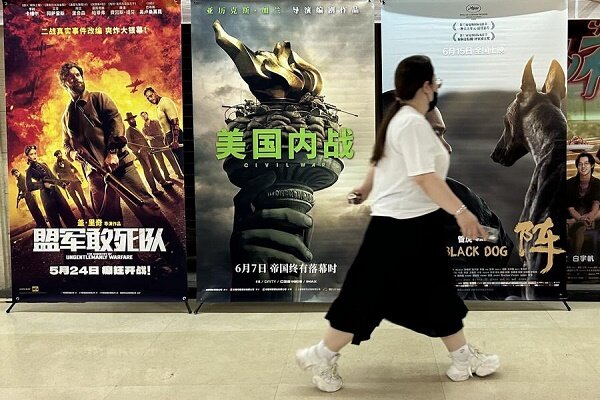US Tariffs Diminish Hollywood’s Allure in China: The Impact on Film Industry Relationships
Chinese animated feature “Ne Zha 2” continues to dominate the box office, showcasing an impressive performance in China’s cinema landscape. According to recent data released this week, this film has generated a staggering 15.2 billion yuan (approximately 2.11 billion U.S. dollars) at China’s box office within just 12 weeks of its release. This remarkable achievement stands in stark contrast to the top-performing American film of the year, “A Minecraft Movie,” which has only managed to accumulate 150 million yuan and has not made its way into China’s top 10 films of 2025. This trend reflects a deeper issue: the growing decline of Hollywood’s influence in the world’s second-largest movie market.
The figures reveal a sobering reality: 2024 marked the second consecutive year in which no Hollywood film managed to reach the one-billion-yuan milestone, a benchmark that was once commonplace. Analysts attribute this decline to several factors, including U.S. tariffs and trade restrictions that are accelerating the downturn for American films in China.
CREATIVE DECLINE IN HOLLYWOOD
Recent industry data paints a clear picture of Hollywood’s diminishing presence in China. According to box office tracker Maoyan, the market share of American films has plummeted from 36 percent in 2018 and 30 percent in 2019 to a mere 14 percent in 2024. This decline goes beyond mere box office figures.
A Weibo user known as “SurfaceMe” expressed their disappointment, stating, “American blockbusters aren’t drawing much of a crowd anymore.” They attributed this shift to a mix of declining quality and diminishing favorability amid ongoing tariff and trade tensions. Rao Shuguang, president of the China Film Critics Association, echoed these sentiments, noting that “the appeal, emotional resonance, and cultural impact of Hollywood films are fading among Chinese audiences.”
Creatively, Hollywood has become conservative, relying heavily on franchises like Marvel. While the visual spectacle remains, viewers are experiencing what Rao refers to as “aesthetic fatigue.” Furthermore, American narratives often feel disconnected from Chinese life, making it increasingly difficult for American films to resonate with local audiences.
SHIFT IN CONTENT CREATION
According to a report from China Film News, original Hollywood productions accounted for just 18.6 percent of all U.S. studio releases in 2024, a significant drop from 40.9 percent in 2000. In stark contrast, sequels, reboots, adaptations, and spinoffs now dominate with an overwhelming 81.4 percent of releases. This cost-effective yet creatively cautious approach has dampened Chinese viewers’ expectations for high-quality cinematic content.
DWINDLING FAVORABILITY AMID TRADE TENSIONS
However, Hollywood’s creative slump is only part of the broader narrative. Industry insiders point to the impact of Washington’s aggressive tariff policy as a significant factor in Hollywood’s diminishing appeal in China. Film is a crucial component of the U.S. services sector, where the United States has historically maintained a substantial trade surplus with China.
According to the U.S. Department of Commerce, U.S. service exports to China have grown more than eightfold from 2001 to 2023, peaking at nearly 40 billion dollars annually. Film and other IP-driven content have long played a key role in maintaining this advantage.
Ming Jinwei, a Beijing-based commentator and blogger, warns that “weaponizing tariffs could backfire by undermining America’s winning sectors.” He emphasizes that irrational U.S. tariffs could trigger a chain reaction, impacting audiences’ engagement with Hollywood films and potentially other cultural exports.
REPERMISSIONS FOR AMERICAN FILMS
The repercussions of Washington’s trade restrictions are already evident in the reception of American cultural exports in China. Franchises like Transformers, Fast & Furious, and even Marvel, which were once box office staples, are now witnessing inconsistent or poor performance.
Dong Wenxin, a film critic and cinema manager in Jinan, Shandong Province, notes that “it’s been rare for an American film to cross the 100 million yuan mark in China in recent years unless it’s something truly special.” He highlights that American films are now facing tough competition not just from Japanese anime but also from European arthouse and regional Asian films.
As tastes continue to shift, Japanese animation maintains a strong following, while films from Europe and Southeast Asia are gaining traction. This year’s surprise hits, such as Italy’s “There’s Still Tomorrow” and Britain’s “National Theatre Live: Prima Facie,” have exceeded expectations, with Thailand’s “How to Make Millions Before Grandma Dies” emerging as a breakout sleeper last year.
LOOKING AHEAD IN CHINA’S FILM MARKET
Looking to the future, Dong predicts that China’s film market will forge closer ties with countries beyond the United States to cater to an increasingly diverse audience. Evidence of this shift is already apparent, as a recent film agreement with Spain aims to enhance collaboration on co-productions, film festivals, and mutual screenings, signifying China’s intention to broaden its cultural partnerships.
The irony of the situation is striking: Washington’s trade restrictions, intended to protect American industries, may inadvertently undermine one of the country’s most influential exports—its cultural impact. Ming Jinwei succinctly puts it, “U.S. tariffs don’t just tax goods—they tax appeal.” In today’s global entertainment economy, once that appeal diminishes, even the strongest cultural influence may struggle to endure.
Republished from: Xinhua






